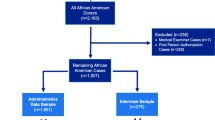Abstract
Background
Transplant candidate caregivers (TCCs) are an under-utilized but potentially devoted pool of advocates who themselves may be recruited to register for deceased organ donation.
Aim
The purpose of this study was to assess and compare recruitment barriers to deceased donor registration efforts in TCCs and health fair attendees (HFAs).
Methods
A 42-item questionnaire assessing willingness to register as an organ donor and perceptions and knowledge about organ donation was administered to 452 participants (174 in Denver, 278 in San Francisco). Logistic regression, stratified by study site, was used to assess associations between explanatory variables and willingness to register as an organ donor.
Results
In Denver, 83 % of TCCs versus 68 % of HFAs indicated a willingness to register (p = 0.03). Controlling for study group (TCC vs HFA), predictors of willingness to register were female gender [odds ratio (OR) 2.4], Caucasian race (OR 2.3), college graduate (OR 11.1), married (OR 2.4) and higher positive perception of organ donation (OR 1.2), each p < 0.05. In San Francisco, 58 % of TCCs versus 70 % of HFAs indicated a willingness to register (p = 0.03). Controlling for study group (TCC vs HFA), predictors of willingness to register were Caucasian race (OR 3.5), college graduate (OR 2.2), married (OR 1.9), higher knowledge (OR 1.6) and higher positive perception of organ donation (OR 1.2), each p < 0.05. In both locales, Caucasians were more likely to have positive perceptions about organ donation and were more willing to register.
Conclusions
Demographic characteristics, not personal connection to a transplant candidate, explain willingness to register as an organ donor.




Similar content being viewed by others
References
Wolfe RA, Merion RM, Roys EC, Port FK. Trends in organ donation and transplantation in the United States, 1998–2007. Am J Transpl. 2009;9:869–878.
Port FK. Organ donation and transplantation trends in the United States, 2001. Am J Transpl. 2003;3:7–12.
Wynn JJ, Alexander CE. Increasing organ donation and transplantation: the U.S. experience over the past decade. Transpl Int. 2011;24:324–332.
SRTR. http://www.srtr.org/csr/current/nats.aspx. Accessed 15 March 2013.
Coombes JM, Trotter JF. Development of the allocation system for deceased donor liver transplantation. Clin Med Res. 2005;3:87–92.
Lai M. Do we need to change our national organ donation policy? Hepatology. 2010;51:1479–1482.
Morgan S, Miller J. Communicating about gifts of life: the effect of knowledge, attitudes, and altruism on behavior and behavioral intentions regarding organ donation. J Appl Commun Res. 2002;30:163–178.
Prottas JM. Encouraging altruism: public attitudes and the marketing of organ donation. Milbank Mem Fund Q Health Soc. 1983;61:278–306.
Cohen EL, Hoffner C. Gifts of giving: the role of empathy and perceived benefits to others and self in young adults’ decisions to become organ donors. J Health Psychol. 2013;18:128–138.
Boulware LE, Ratner LE, Sosa JA, Cooper LA, LaVeist TA, Powe NR. Determinants of willingness to donate living related and cadaveric organs: identifying opportunities for intervention. Transplantation. 2002;73:1683–1691.
Boulware LE, Ratner LE, Cooper LA, Sosa JA, LaVeist TA, Powe NR. Understanding disparities in donor behavior: race and gender differences in willingness to donate blood and cadaveric organs. Med Care. 2002;40:85–95.
Siminoff LA, Gordon N, Hewlett J, Arnold RM. Factors influencing families’ consent for donation of solid organs for transplantation. JAMA. 2001;286:71–77.
Bratton C, Chavin K, Baliga P. Racial disparities in organ donation and why. Curr Opin Organ Transpl. 2011;16:243–249.
Haustein SV, Sellers MT. Factors associated with (un)willingness to be an organ donor: importance of public exposure and knowledge. Clin Transpl. 2004;18:193–200.
Yuen CC, Burton W, Chiraseveenuprapund P, et al. Attitudes and beliefs about organ donation among different racial groups. J Natl Med Assoc. 1998;90:13–18.
Rady MY, McGregor JL, Verheijde JL. Mass media campaigns and organ donation: managing conflicting messages and interests. Med Health Care Philos. 2012;15:229–241.
Quick BL, Bosch D, Morgan SE. Message framing and medium considerations for recruiting newly eligible teen organ donor registrants. Am J Transpl. 2012;12:1593–1597.
Salim A, Berry C, Ley EJ, Schulman D, Navarro S, Chan LS. Utilizing the media to help increase organ donation in the Hispanic American population. Clin Transpl. 2011;25:E622–E628.
D’Alessandro AM, Peltier JW, Dahl AJ. The impact of social, cognitive and attitudinal dimensions on college students’ support for organ donation. Am J Transpl. 2012;12:152–161.
Zheng P, Kornfield R, Olmo C, Guy J, Inadomi J, Biggins SW. Reduced effectiveness of standard recruitment for deceased organ donor registration: the need for population-specific recruitment materials. Dig Dis Sci. 2011;56:1535–1541.
Siminoff LA, Lawrence RH, Arnold RM. Comparison of black and white families’ experiences and perceptions regarding organ donation requests. Crit Care Med. 2003;31:146–151.
Siminoff LA, Burant CJ, Ibrahim SA. Racial disparities in preferences and perceptions regarding organ donation. J Gen Intern Med. 2006;21:995–1000.
Brown ER. African American present perceptions of organ donation: a pilot study. ABNF J. 2012;23:29–33.
Alden DL, Cheung AH. Organ donation and culture: a comparison of Asian American and European American beliefs, attitudes, and behaviors. J Appl Soc Psychol. 2000;30:293–314.
Breitkopf CR. Attitudes, beliefs and behaviors surrounding organ donation among Hispanic women. Curr Opin Organ Transpl. 2009;14:191–195.
Acknowledgments
This work was funded in part by grants from the National Institute of Diabetes and Digestive and Kidney Diseases (DK076565) and from the Agency for Healthcare Research and Quality (DK076565) to S.W.B.
Conflict of interest
None.
Author information
Authors and Affiliations
Corresponding author
Electronic supplementary material
Below is the link to the electronic supplementary material.
Rights and permissions
About this article
Cite this article
Regalia, K., Zheng, P., Sillau, S. et al. Demographic Factors Affect Willingness to Register as an Organ Donor More Than a Personal Relationship with a Transplant Candidate. Dig Dis Sci 59, 1386–1391 (2014). https://doi.org/10.1007/s10620-014-3053-2
Received:
Accepted:
Published:
Issue Date:
DOI: https://doi.org/10.1007/s10620-014-3053-2




